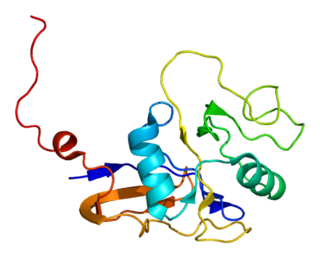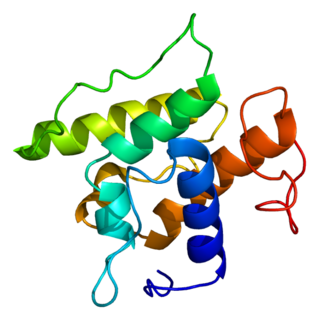
GroEL is a protein which belongs to the chaperonin family of molecular chaperones, and is found in many bacteria. It is required for the proper folding of many proteins. To function properly, GroEL requires the lid-like cochaperonin protein complex GroES. In eukaryotes the organellar proteins Hsp60 and Hsp10 are structurally and functionally nearly identical to GroEL and GroES, respectively, due to their endosymbiotic origin.

BAG family molecular chaperone regulator 1 is a protein that in humans is encoded by the BAG1 gene.

Homeobox protein Nkx-3.1, also known as NKX3-1, NKX3, BAPX2, NKX3A and NKX3.1 is a protein that in humans is encoded by the NKX3-1 gene located on chromosome 8p. NKX3-1 is a prostatic tumor suppressor gene.

Proliferation-associated protein 2G4 (PA2G4) also known as ErbB3-binding protein 1 (EBP1) is a protein that in humans is encoded by the PA2G4 gene.

DNA-binding protein inhibitor ID-1 is a protein that in humans is encoded by the ID1 gene.

DnaJ homolog subfamily B member 1 is a protein that in humans is encoded by the DNAJB1 gene.

FK506 binding protein 5, also known as FKBP5, is a protein which in humans is encoded by the FKBP5 gene.

Disintegrin and metalloproteinase domain-containing protein 9 is an enzyme that in humans is encoded by the ADAM9 gene.

Nuclear autoantigenic sperm protein is a protein that in humans is encoded by the NASP gene. Multiple isoforms are encoded by transcript variants of this gene.

Heat shock protein 105 kDa is a protein that in humans is encoded by the HSPH1 gene.

Transgelin is a protein that in humans is encoded by the TAGLN gene.

Myb-binding protein 1A is a protein that in humans is encoded by the MYBBP1A gene.

40S ribosomal protein S16' is a protein that in humans is encoded by the RPS16 gene.

60S ribosomal protein L4 is a protein that in humans is encoded by the RPL4 gene.

CCAAT/enhancer-binding protein zeta is a protein that in humans is encoded by the CEBPZ gene.

Heat shock 70 kDa protein 14 also known as HSP70-like protein 1 or heat shock protein HSP60 is a protein that in humans is encoded by the HSPA14 gene.

40S ribosomal protein S26 is a protein that in humans is encoded by the RPS26 gene.

DnaJ homolog subfamily B member 11 is a protein that in humans is encoded by the DNAJB11 gene.

Krueppel-like factor 12 is a protein that in humans is encoded by the KLF12 gene.

Transmembrane prostate androgen-induced protein is a protein that in humans is encoded by the PMEPA1 gene.




















